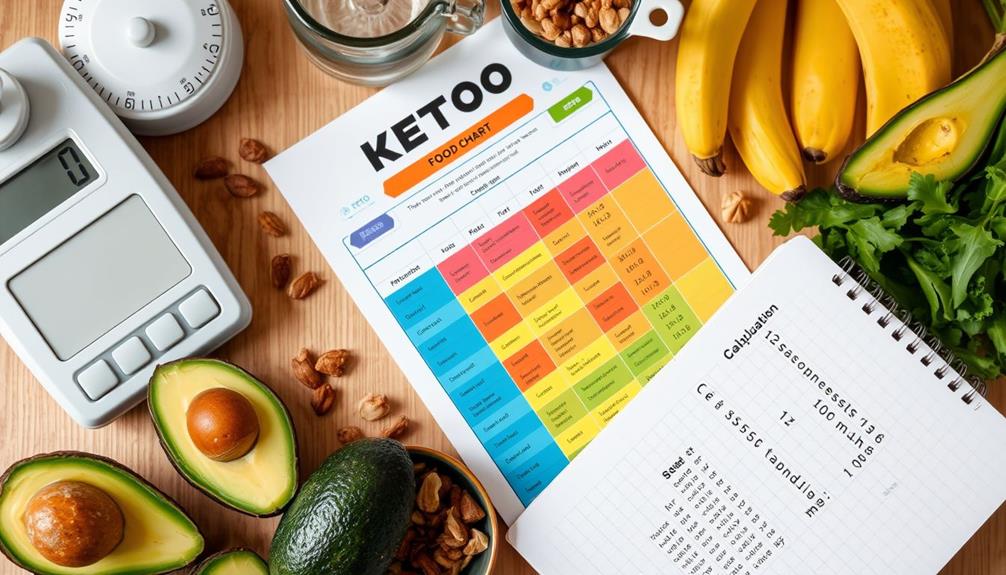To track your keto diet, start by understanding your macros: aim for 70-75% fat, 20-25% protein, and 5-10% carbs. You can use tracking apps like MyFitnessPal or Carb Manager to log your meals, which helps you stay accountable. Measure portions accurately to avoid hidden carbs often found in sauces and processed foods. Don't forget to plan your meals to prevent unhealthy choices. Regularly reassess your macro goals as your body changes. This approach guarantees you maintain ketosis effectively. Want to uncover more tips and tricks for succeeding with keto? If you’re just starting your keto diet journey, it’s important to educate yourself about the potential side effects of the transition, commonly known as the “keto flu.” Stay hydrated, replenish electrolytes, and be patient as your body adjusts to burning fat for fuel instead of carbohydrates. It’s also beneficial to consult with a healthcare professional or nutritionist before starting keto diet, especially if you have any pre-existing health conditions. With the right information and support, you can set yourself up for success on your keto diet journey.
Key Takeaways
- Determine your macronutrient ratios, targeting 70-75% fat, 20-25% protein, and 5-10% carbohydrates for effective ketosis.
- Use tracking apps like MyFitnessPal or Carb Manager to simplify meal logging and monitor your macro intake.
- Measure portion sizes accurately to avoid underestimating calories and hidden carbohydrates in sauces and processed foods.
- Regularly reassess your macro goals based on changes in body composition and activity levels to maintain energy and adherence.
- Keep a food journal to enhance accountability, identify eating patterns, and make informed dietary decisions aligned with keto targets.
Understanding Keto Macros

When you plunge into the keto diet, understanding your macros is vital for success. The keto lifestyle is all about consuming 70-75% fat, 20-25% protein, and only 5-10% carbohydrates. This macronutrient balance helps you maintain ketosis, a metabolic state that promotes effective fat burning and weight loss.
To track your macros accurately, measuring food portions is essential. Additionally, be mindful of your hydration levels, as maintaining proper fluid intake can support your overall health during this dietary shift, similar to how celery juice acts as a natural diuretic. Don't forget to check for hidden carbs in sauces or dressings, which can throw off your ratios.
Using tracker apps like MyFitnessPal or Cronometer can make this process easier. These nutrition trackers provide calorie percentages from each nutrient, allowing you to stay within your desired ranges.
Remember, excessive protein intake can hinder ketosis, so prioritize your fat consumption while keeping an eye on protein and carbs. Regularly adjusting your macronutrient ratios based on your individual goals is also important.
Importance of Macro Tracking
Tracking your macros is a game changer on the keto diet. It's essential for maintaining ketosis and achieving your weight loss goals. By accurately monitoring your macro percentages, you can guarantee you're hitting the right balance of fats, proteins, and carbs.
Incorporating a balanced diet rich in healthy fats, as emphasized in effective strategies for weight loss, can further enhance your results. Here's why it matters:
- Prevents excessive protein intake, which can hinder ketosis
- Helps you stay within your carb limits, promoting fat burning
- Increases awareness of your calorie intake and food choices
- Encourages healthy eating habits for long-term success
- Allows for regular adjustments based on your goals
Using a macro tracker or food journal simplifies logging your daily intake and calculating your macro percentages. This diligence not only enhances your understanding of what you eat but also boosts your energy levels.
Regularly adjusting your macros based on your Basal Metabolic Rate (BMR) and Total Daily Energy Expenditure (TDEE) is key to maintaining your dietary goals. So, make macro tracking a priority—it's a straightforward way to elevate your keto journey and guarantee you stay on track!
Tools for Tracking Macros
A variety of tools can make tracking your macros on the keto diet both easy and efficient. Using a keto diet tracker like Carb Manager or MyFitnessPal allows you to log your meals quickly, thanks to features like a barcode scanner that helps you input foods with minimal hassle.
These apps provide nutritional information for over a million foods, making it simple to track macros and make healthy choices. Additionally, exploring best websites to earn money online can provide insights on how to fund your keto journey through various income opportunities.
In addition to apps, food journaling can enhance your tracking accuracy. By calculating macronutrients from nutrition labels and weighing your food portions, you hold yourself accountable for your daily intake.
If you prefer a more personalized approach, consider creating custom spreadsheet templates to monitor your macros in a way that fits your habits.
Don't forget to integrate fitness apps and devices, such as Apple Health or Google Fit, into your routine. They provide an all-encompassing view of your overall health metrics, making it easier to align your macro intake with your fitness goals.
Regularly adjusting your macronutrient ratios based on your Basal Metabolic Rate (BMR) and Total Daily Energy Expenditure (TDEE) is essential for successful tracking on the keto diet.
Common Tracking Mistakes
Many people overlook common mistakes that can undermine their efforts on the keto diet. To stay on track, it's imperative to be aware of these pitfalls in tracking your macros.
Proper tracking is similar to creating a personal budget where every detail matters, and understanding common financial terms can help highlight the importance of accuracy when managing your diet.
- Underestimating portion sizes: Accurately measuring can prevent excessive calorie intake.
- Neglecting hidden carbohydrates: Sauces, dressings, and processed foods can sneak in carbs you mightn't count.
- Focusing only on protein intake: Don't forget to consume enough fats to maintain the desired macronutrient ratios.
- Inconsistent tracking: Regularly logging your food helps guarantee adherence to the keto lifestyle.
- Ignoring alcohol effects: Many drinks contain hidden sugars and carbs that can derail your progress.
Benefits of Tracking Macros

Maintaining a clear understanding of your macronutrient intake is vital for the success of your keto diet. Tracking macros allows you to guarantee that fat intake remains at 70-75%, protein at 20-25%, and carbohydrates at only 5-10% of your total daily calories. This accuracy can lead to better weight loss and body composition results, helping you adjust your intake based on your specific energy needs and goals.
Additionally, being aware of how your diet impacts overall health can provide insights into other areas, such as the importance of staying hydrated, which is essential for overall well-being and can support your keto efforts the role of hydration.
Using a Keto diet app like MyFitnessPal or Cronometer makes tracking macros easier, as these tools automatically calculate calorie percentages from each macronutrient. Consistent tracking helps prevent excessive protein intake, which can hinder your ability to stay in ketosis, and allows you to spot hidden carbs in sauces or dressings.
Enhanced awareness of your food choices through tracking macros promotes healthier eating habits. By monitoring your meal plans and understanding net carbs, you can improve your energy levels and support your overall well-being.
Ultimately, tracking macros is a powerful tool that can help you achieve and maintain your keto diet goals effectively.
App Features for Keto Tracking
Keto tracking apps frequently offer a variety of features designed to simplify your dietary journey. By utilizing these tools, you can effortlessly manage your keto lifestyle and stay on track with your goals. Here are some standout features you'll love:
– Macronutrient tracking: Monitor your fats, proteins, and carbs easily. This feature is essential for maintaining the correct ratios for your keto diet, which is vital for effective results.
Many users find it beneficial to incorporate yoga for back pain as part of their routine to enhance overall wellness while dieting.
- Barcode scanning: Quickly log packaged foods with a simple scan.
- Personalized meal plans: Get meal suggestions tailored to your preferences and goals.
- Shopping lists: Generate grocery lists based on your meal plans to streamline your shopping trips.
- Fitness tracking: Integrate with health apps to monitor your physical activity alongside your dietary intake.
With a robust Keto app, you'll find extensive databases filled with food entries, making meal logging a breeze. Some apps even offer advanced features like photo recognition for added convenience.
Plus, built-in keto calculators and macro trackers help you maintain your desired ratios effectively. By leveraging these features, you can enhance your keto journey and make smarter dietary choices, all while keeping the process enjoyable and less time-consuming.
Meal Logging Techniques
When it comes to tracking your keto diet, effective meal logging is key. You can use apps for quick entries, keep a food journal for real-time accountability, or even create your own tracking system with spreadsheets. Mastering the keto diet requires a keen understanding of macronutrient ratios and diligent tracking of your daily food intake. By consistently logging your meals and snacks, you can monitor your carb, protein, and fat consumption to ensure you’re staying within the parameters of the keto diet. Whether you prefer digital or pen-and-paper tracking, finding a method that works for you is essential in mastering the keto diet.
Additionally, embracing unique brewing methods like French press coffee can complement your diet by offering delicious low-carb beverage options. Each method has its benefits, so find the one that works best for you.
Effective App Usage
Tracking your meals effectively is essential for success on a keto diet, and using the right apps can make this task considerably easier. Incorporating wellness practices like aromatherapy can also complement your health journey, especially with essential oils for respiratory health to support overall well-being.
Here are some features to look for in meal logging apps:
- Barcode scanning for quick entry of food items.
- Broad food databases to easily find low-carb recipes.
- Photo recognition in premium versions for effortless logging.
- Customizable tracking systems to meet your specific dietary needs.
- Syncing capabilities with fitness devices for thorough tracking.
Apps like Carb Manager and MyFitnessPal are great choices. They're easy to use and simplify logging your meals. Taking advantage of premium features like photo recognition allows you to log meals faster, ensuring accurate tracking of your carb intake.
Additionally, create a personalized tracking system using spreadsheet tools to tailor your logging experience.
Don't forget to regularly sync your app with fitness devices to monitor calories burned and activity levels. This can help inform adjustments to your dietary plan, ensuring you stay on track with your keto goals while respecting your privacy practices may include.
Food Journal Benefits
Maintaining a food journal can considerably enhance your keto journey by ensuring you're accurately logging your meals in real-time. This practice not only helps you track your macronutrient intake but also prevents dietary slip-ups that could derail your progress.
When you write down what you eat, you increase your accountability and mindfulness, making it easier to spot patterns that lead to cravings or overeating. Additionally, being aware of your emotional and psychological growth can help you navigate the challenges of dietary changes, as development influenced by biological, cognitive, and social factors plays a significant role in your eating habits and choices.
A food journal is particularly useful for recognizing hidden carbs in sauces and dressings, which are often overlooked but can disrupt your state of ketosis. By consistently recording your meals, you can stay within your daily carb limit, an essential factor for maintaining ketosis.
Moreover, visually tracking your intake allows you to adjust your meal choices and portion sizes effectively. This ongoing assessment supports your weight management goals and keeps you aligned with your health objectives.
With a food journal, you empower yourself to make informed decisions, ensuring that every bite you take brings you closer to your keto targets. Embrace this tool, and watch your keto journey flourish!
DIY Tracking Methods
For those on a keto journey, implementing DIY tracking methods can greatly streamline the process of managing your macronutrient intake, which is essential for maintaining a successful diet.
High-quality content about the importance of keyword research can also enhance your understanding of how to optimize your tracking efforts. Here are some effective techniques to reflect on:
- Utilize Carb Manager: This app simplifies meal logging with barcode scanning and photo recognition, making it easy to track macros on-the-go.
- Explore KetoDiet Apps: With over 1 million food entries for nutritional logging, these apps also offer keto-friendly recipes, perfect for meal planning.
- Maintain a Food Journal: Keeping a detailed food journal helps you stay accountable and identify patterns that may lead to dietary slip-ups.
- Create a DIY Tracking System: Design a personalized spreadsheet on Google Docs to track macros and calories, tailored to your preferences.
- Plan Meals in Advance: Pre-tracking meals minimizes the risk of unhealthy choices and guarantees you stick to your keto guidelines.
Adjusting Your Macro Goals

Adjusting your macro goals is vital for staying on track with the ketogenic diet and achieving your desired results. Start by calculating your Basal Metabolic Rate (BMR) and Total Daily Energy Expenditure (TDEE) to determine your caloric needs based on your activity levels.
The ketogenic diet typically consists of 70-75% fat, 20-25% protein, and 5-10% carbohydrates. Adjust your food intake to align with these macro ratios for peak ketosis.
As you progress towards your weight loss or maintenance goals, regularly reassess your macro goals to guarantee they suit your changing body composition and activity levels. Using macro tracker apps like MyFitnessPal or Carb Manager can help you log your food intake and make necessary adjustments in real-time.
It's important to gradually modify your macro goals to avoid overwhelming yourself. This approach keeps your daily intake in check while supporting sustained energy levels and adherence to the keto diet.
Frequently Asked Questions
How Do I Track My Keto Meals?
To track your meals, use apps like MyFitnessPal for easy logging. Keep a food journal to jot down daily intake, measure portions accurately, and plan meals ahead to stay on track with your goals.
How Do I Calculate My Keto Diet?
To calculate your keto diet, find your BMR and TDEE. Then, aim for 70-75% fats, 20-25% protein, and 5-10% carbs. Adjust your intake based on your weight loss progress and activity level.
How Do I Check My Keto Level?
Imagine a treasure hunt where the prize is ideal health. To check your keto level, you've got options: blood tests, urine strips, or breath analyzers. Each method reveals your progress on this delicious journey.
Can I Use Myfitnesspal to Track Keto?
Yes, you can use MyFitnessPal to track your keto diet. You'll customize macro goals, log meals easily, and monitor your intake of fats, proteins, and carbs, ensuring you stay within your desired ranges for ketosis.
Conclusion
Tracking your keto diet doesn't have to feel overwhelming. Imagine effortlessly logging your meals and watching your progress unfold, like a painter layering colors on a canvas. By understanding your macros and using the right tools, you'll see how small adjustments can lead to big results. Don't worry about perfection; just focus on consistency. Soon enough, you'll find yourself feeling more energized and in control, making your keto journey not just successful, but enjoyable too!









